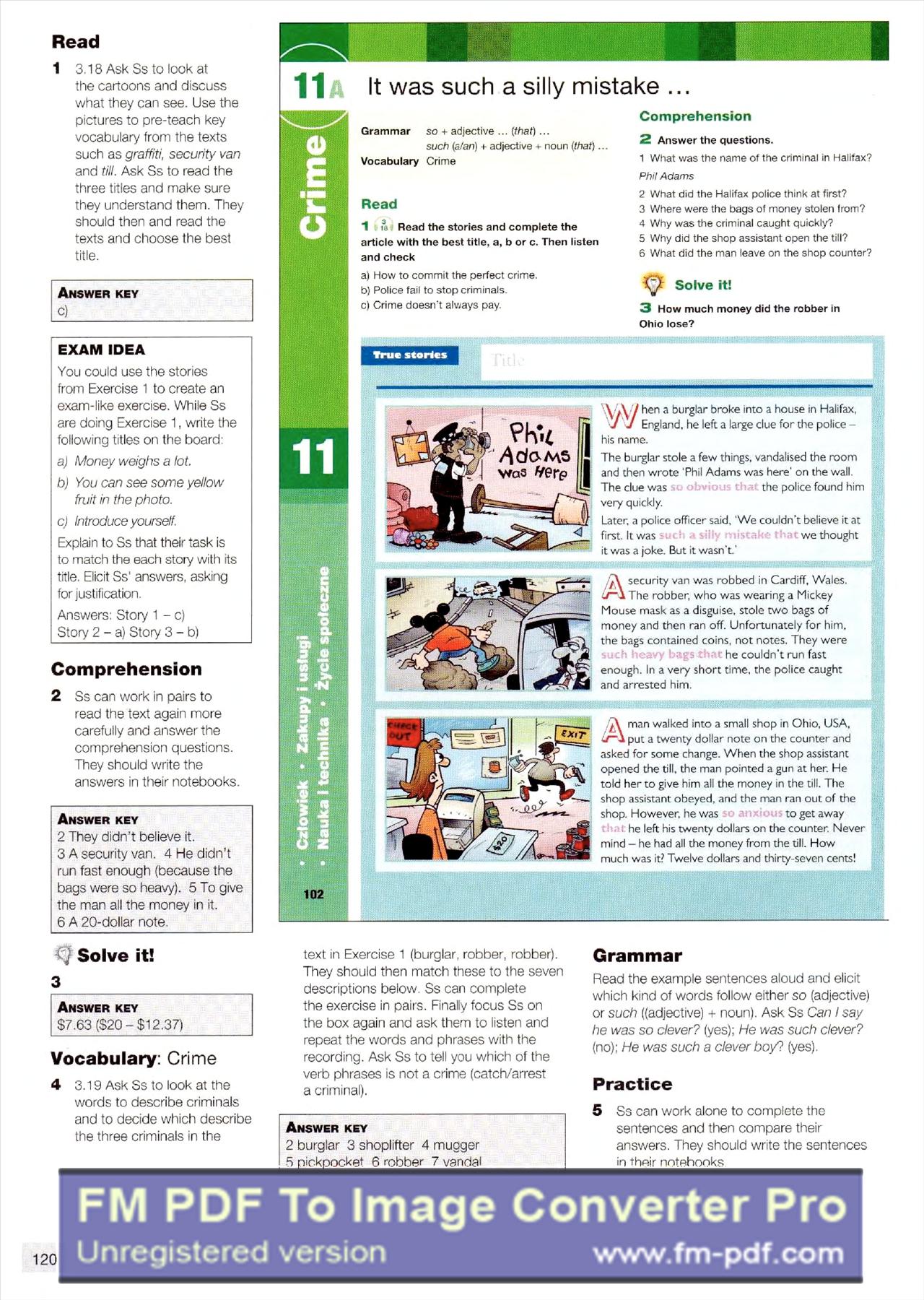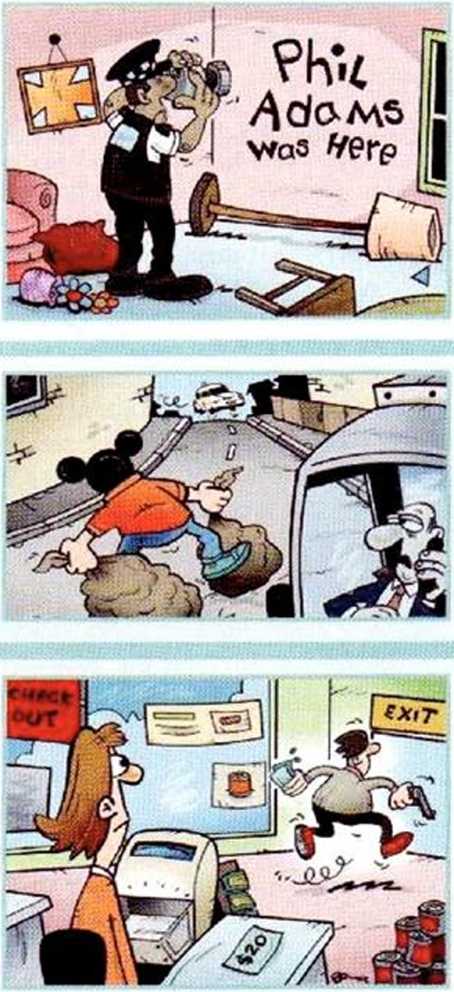Up¾at 3 Teacher's Book podrecznik nauczyciela plus odpowiedzi ,testy,klucz answer key Page 119

Read
1 3.18 Ask Ss to look at the cartoons and discuss what they can see. Use the pictures to pre-teach key vocabulary from the texts such as graffiti, security van and till. Ask Ss to read the three titles and make surÄ™ they understand them. They should then and read the texts and choose the best title.

Grammar so + adjective ... {that)...
such (a/an) + adjective + noun (that)... Yocabulary Crime
Comprehension
2 Answer the questions.
1 What was the name of the cnmmal in Halifax? Phil Adams

Read
1 to Read the stories and complete the article with the best title, a, b or c. Then listen and check
2 What did the Halifax police thmk at first?
3 Where were the bags of money stolen from?
4 Why was the criminal caught quickly?
5 Why did the shop assistant open the till?
6 What did the man leave on the shop counter?
a) How to commit the perfect crime.
b) Police fail to stop criminals.
c) Crime doesn t always pay.
Solve it!
3 How much money did the robber in Ohio lose?
EXAM IDEA
You could use the Stones from Exercise 1 to create an exam-like exercise. While Ss are doing Exercise 1, write the following titles on the board:
a) Money weighs a lot.
b) You can see sonie yellow fruit in the photo.
c) Introduce yourseff.
Explain to Ss that their task is to match the each story with its title. Elicit Ss' answers, asking for justification.
Answers: Story 1 - c)
Story 2-a) Story 3 - b)
Comprehension
2 Ss can work in pairs to read the text again morÄ™ carefully and answer the comprehension guestions. They should write the answers in their notebooks.
Answer key
2 They didn’t believe it.
3 A security van. 4 He didn’t run fast enough (because the bags were so heavy). 5 To give the man all the money in it.
6 A 20-dollar notÄ™.
^ Solve it!
3___
Answer key
$7.63 ($20- $12.37)

Truć stories

When a burglar broke into a house in Halifax.
England. he left a large clue for the police his name.
The burglar stole a few things. vandalised the room and then wrote 'Phil Adams was here' on the wali. The clue was the police found him
very quickly.
Later. a police officer said, ‘We couldn‘t believe it at first. It was we thought
it was a joke. But it wasn't.'
/y\ security van was robbed in Cardiff, Wales. J~\ The robber, who was wearing a Mickey Mouse mask as a disguise, stole two bags of money and then ran off. Unfortunately for him. the bags contained coins, not notes. They were
he couldn’t run fast
enough. In a very short time. the police caught and arrested him.
A man walked into a smali shop in Ohio. USA, put a twenty dollar notÄ™ on the counter and asked for some change. When the shop assistant opened the till. the man pointed a gun at her. He told her to give him all the money in the till. The shop assistant obeyed. and the man ran out of the shop. However. he was to get away
. he left his twenty dollars on the counter. Never mind - he had all the money from the till. How much was it? Twelve dollars and thirty-seven cents!
m



Vocabulary Crime
4 3.19 Ask Ss to look at the words to describe criminals and to decide which describe the three criminals in the
text in Exercise 1 (burglar. robber, robber). They should then match these to the seven descriptions below. Ss can complete the exercise in pairs. Finally focus Ss on the box again and ask them to listen and repeat the words and phrases with the recording. Ask Ss to tell you which of the verb phrases is not a crime (catch/arrest a criminal).
Grammar
Read the example sentences aloud and elicit which kind of words follow either so (adjective) or such ((adjective) + noun). Ask Ss Can I say he was so clever? (yes); He was such cfever? (no); He was such a clever boy? (yes).
Practice
5 Ss can work alone to complete the sentences and then compare their answers. They should write the sentences in their notehooks_
Wyszukiwarka
Podobne podstrony:
Up?at 3 Teacher s Book podrecznik nauczyciela plus odpowiedzi ,testy,klucz answer key Page 029 Dialo
Up?at 3 Teacher s Book podrecznik nauczyciela plus odpowiedzi ,testy,klucz answer key Page 111 Quick
Up?at 3 Teacher s Book podrecznik nauczyciela plus odpowiedzi ,testy,klucz answer key Page 036 Com 2
Up?at 3 Teacher s Book podrecznik nauczyciela plus odpowiedzi ,testy,klucz answer key Page 109 Read
Up?at 3 Teacher s Book podrecznik nauczyciela plus odpowiedzi ,testy,klucz answer key Page 222 nice.
Up?at 3 Teacher s Book podrecznik nauczyciela plus odpowiedzi ,testy,klucz answer key Page 091 Read
Up?at 3 Teacher s Book podrecznik nauczyciela plus odpowiedzi ,testy,klucz answer key Page 125 1 &nb
Up?at 3 Teacher s Book podrecznik nauczyciela plus odpowiedzi ,testy,klucz answer key Page 193 Read
Up?at 3 Teacher s Book podrecznik nauczyciela plus odpowiedzi ,testy,klucz answer key Page 001 FM PD
Up?at 3 Teacher s Book podrecznik nauczyciela plus odpowiedzi ,testy,klucz answer key Page 005 Conte
Up?at 3 Teacher s Book podrecznik nauczyciela plus odpowiedzi ,testy,klucz answer key Page 006 Conte
więcej podobnych podstron